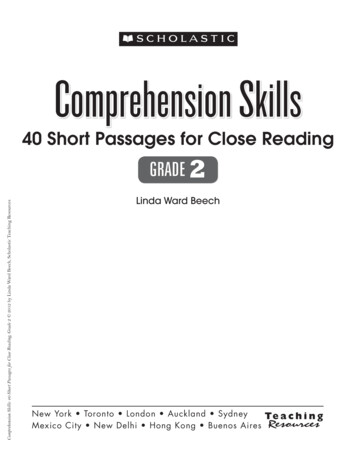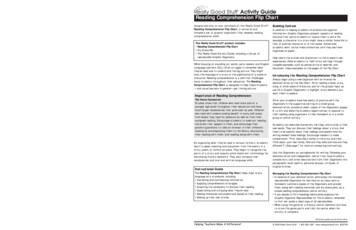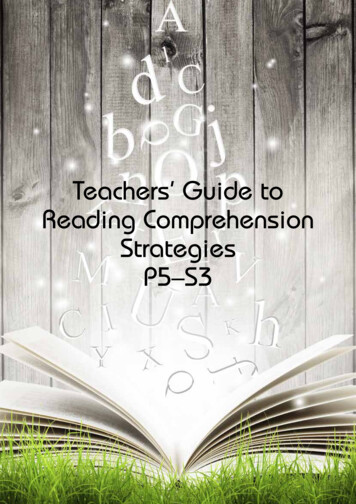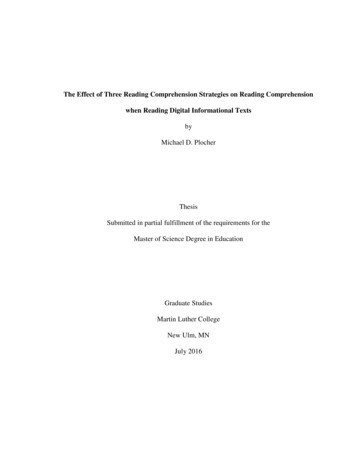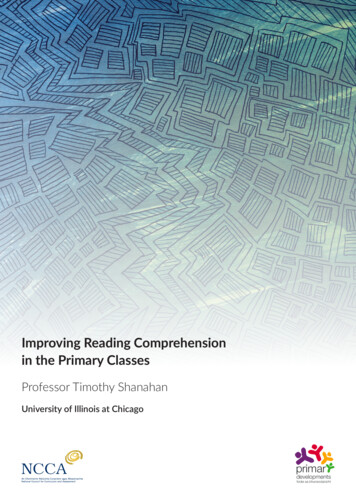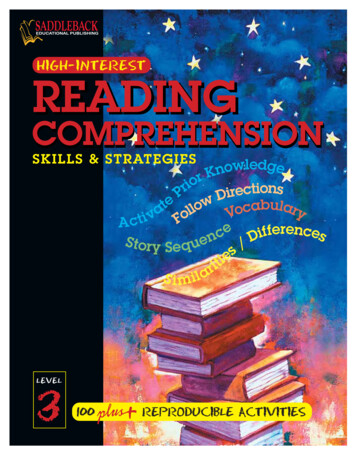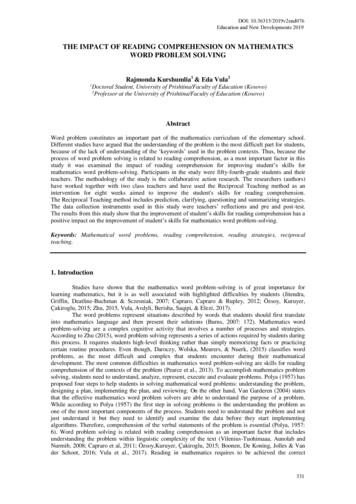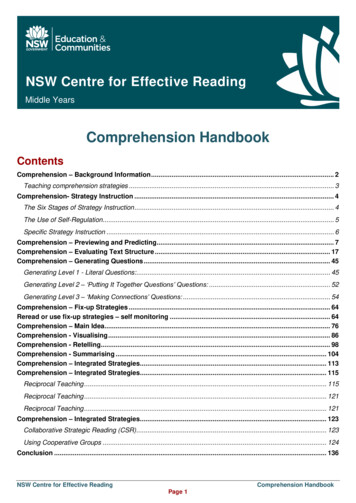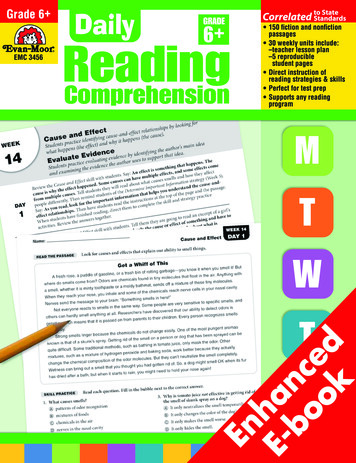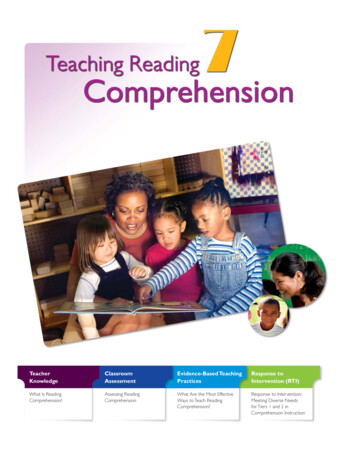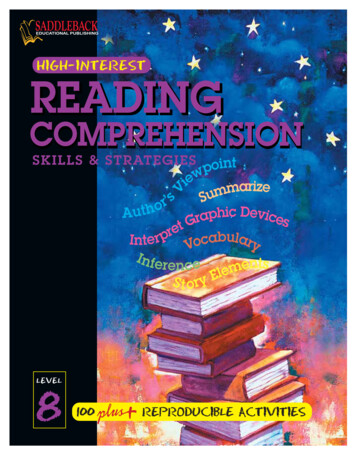
Transcription
HIGH-INTERESTSKILLS & STRATEGIESVointpwiearizemmSu’r sA ut h ophic DevicesarGterpabularyrInt ecoVIn fentseren c emleES t o ryLEVEL8100REPRODUCIBLE ACTIVITIES
Reading ComprehensionSkills and StrategiesLevel 8Saddleback Educational PublishingThree WatsonIrvine, CA 92618-2767Web site: www.sdlback.comDevelopment and Production:The EDGeISBN 1-56254-035-1Copyright 2002 by Saddleback Educational Publishing. All rights reserved. No part of this book may be reproduced in anyform or by any means, electronic or mechanical, including photocopying, recording, or by any information storage andretrieval system, without written permission of the publisher, with the following exception.Pages labeled Saddleback Educational Publishing 2002 are intended for reproduction. Saddleback EducationalPublishing grants to individual purchasers of this book the right to make sufficient copies of reproducible pages for use by allstudents of a single teacher. This permission is limited to an individual teacher, and does not apply to entire schools orschool systems.Printed in the United States of America06 05 04 03 02 9 8 7 6 5 4 3 2 1
Table of ContentsTo be a good detective, you have to know what factsSkillsare important andnot important to the case you’resolving! So, ask yourself questions as you read.Teacher welcome and teaching tips . . . . . . . . . 4Identifying antonyms . . . . . . . . . . . . . . . . . . . 37Analyzing prefixes . . . . . . . . . . . . . . . . . . . . . . . 6Recognizing synonyms and antonyms . . . . . .38Analyzing prefixes . . . . . . . . . . . . . . . . . . . . . . . 7Recognizing synonyms and antonyms . . . . . .39Analyzing suffixes . . . . . . . . . . . . . . . . . . . . . . .8Identifying homonyms . . . . . . . . . . . . . . . . . . .40Recognizing prefixes and suffixes . . . . . . . . . . . 9Identifying homonyms . . . . . . . . . . . . . . . . . . .41Analyzing Latin roots . . . . . . . . . . . . . . . . . . . 10Using homonyms . . . . . . . . . . . . . . . . . . . . . . .42Analyzing Greek roots . . . . . . . . . . . . . . . . . . . 11Recognizing near-misses . . . . . . . . . . . . . . . . . .43Recognizing root words . . . . . . . . . . . . . . . . . . 12Recognizing signal words . . . . . . . . . . . . . . . . .44Differentiating plurals and possessives . . . . . . 13Identifying abbreviations . . . . . . . . . . . . . . . . .45Using context clues . . . . . . . . . . . . . . . . . . . . . 14Recognizing the 5 W’s . . . . . . . . . . . . . . . . . . . .46Using context clues . . . . . . . . . . . . . . . . . . . . . 15Recognizing the 5 W’s . . . . . . . . . . . . . . . . . . . .47Using context clues . . . . . . . . . . . . . . . . . . . . . 16Applying the 5 W’s . . . . . . . . . . . . . . . . . . . . . .48Using context clues . . . . . . . . . . . . . . . . . . . . . 17Identifying sequence . . . . . . . . . . . . . . . . . . . . .49Using context clues . . . . . . . . . . . . . . . . . . . . . 18Identifying sequence . . . . . . . . . . . . . . . . . . . . .50Using context clues . . . . . . . . . . . . . . . . . . . . . 19Identifying sequence . . . . . . . . . . . . . . . . . . . . .51Using context clues . . . . . . . . . . . . . . . . . . . . . 20Recognizing sequence . . . . . . . . . . . . . . . . . . . .52Using context clues . . . . . . . . . . . . . . . . . . . . . 21Identifying fact and opinion . . . . . . . . . . . . . .53Using context clues . . . . . . . . . . . . . . . . . . . . . 22Identifying fact and opinion . . . . . . . . . . . . . .54Using context clues . . . . . . . . . . . . . . . . . . . . . 23Classifying and categorizing . . . . . . . . . . . . . .55Using context clues . . . . . . . . . . . . . . . . . . . . . 24Classifying and categorizing . . . . . . . . . . . . . .56Analyzing analogies . . . . . . . . . . . . . . . . . . . . 25Classifying and categorizing . . . . . . . . . . . . . .57Analyzing analogies . . . . . . . . . . . . . . . . . . . . 26Identifying cause and effect . . . . . . . . . . . . . . .58Analyzing analogies . . . . . . . . . . . . . . . . . . . . 27Applying cause and effect . . . . . . . . . . . . . . . .59Analyzing analogies . . . . . . . . . . . . . . . . . . . . 28Differentiating main idea/details . . . . . . . . . . .60Analyzing analogies . . . . . . . . . . . . . . . . . . . . 29Recognizing main idea/details . . . . . . . . . . . . .61Analyzing analogies . . . . . . . . . . . . . . . . . . . . 30Recognizing main idea/details . . . . . . . . . . . . .62Analyzing multiple meanings . . . . . . . . . . . . . 31Recognizing main idea/details . . . . . . . . . . . . .63Analyzing multiple meanings . . . . . . . . . . . . . 32Recognizing main idea/details . . . . . . . . . . . . .64Analyzing multiple meanings . . . . . . . . . . . . . 33Identifying relevant/irrelevant details . . . . . . .65Analyzing multiple meanings . . . . . . . . . . . . . 34Identifying relevant/irrelevant details . . . . . . .66Analyzing multiple meanings . . . . . . . . . . . . . 35Constructing an outline from topics . . . . . . . .67Identifying synonyms . . . . . . . . . . . . . . . . . . . 36Drawing conclusions and inferences . . . . . . . .682
Drawing conclusions and inferences . . . . . . . .69Switching point of view . . . . . . . . . . . . . . . . .105Drawing conclusions and inferences . . . . . . . .70Applying various points of view . . . . . . . . . .106Drawing conclusions and inferences . . . . . . . .71Comparing points of view . . . . . . . . . . . . . . .107Defining idioms . . . . . . . . . . . . . . . . . . . . . . . .72Identifying reading purpose: describe, instruct,inform, persuade, summarize, entertain .108Compare and contrast . . . . . . . . . . . . . . . . . . .73Identifying reading purpose: describe, instruct,inform, persuade, summarize, entertain .109Compare and contrast . . . . . . . . . . . . . . . . . . .74Compare and contrast . . . . . . . . . . . . . . . . . . .75Compare and contrast . . . . . . . . . . . . . . . . . . .76Understanding purpose: describe, instruct,inform, persuade, summarize, entertain .110Identifying similes and metaphors . . . . . . . . .77Multiple comprehension skills . . . . . . . . . . . .111Identifying idioms . . . . . . . . . . . . . . . . . . . . . . .78Multiple comprehension skills . . . . . . . . . . . .112Differentiating similes, metaphors, idioms . . .79Multiple comprehension skills . . . . . . . . . . . .113Recognizing exaggeration . . . . . . . . . . . . . . . .80Multiple comprehension skills . . . . . . . . . . . .114Recognizing and applying exaggeration . . . . .81Alphabetical order (to third letter) . . . . . . . . .115Making generalizations . . . . . . . . . . . . . . . . . .82Alphabetizing titles and names . . . . . . . . . . .116Recognizing valid/invalid generalizations . . . .83Using a dictionary–guide words . . . . . . . . . . .117Recognizing valid/invalid generalizations . . . .84Using a dictionary–pronunciation . . . . . . . . .118Summarizing . . . . . . . . . . . . . . . . . . . . . . . . . . .85Using a dictionary–search . . . . . . . . . . . . . . .119Summarizing . . . . . . . . . . . . . . . . . . . . . . . . . . .86Using a glossary . . . . . . . . . . . . . . . . . . . . . . .120Summarizing . . . . . . . . . . . . . . . . . . . . . . . . . . .87Using a table of contents . . . . . . . . . . . . . . . .121Previewing and predicting . . . . . . . . . . . . . . . .88Using an index . . . . . . . . . . . . . . . . . . . . . . . .122Previewing author’s point of view . . . . . . . . . .89Reading a timeline . . . . . . . . . . . . . . . . . . . . .123Applying author’s point of view . . . . . . . . . . . .90Reading graphs (bar and line) . . . . . . . . . . . .124Previewing by skimming . . . . . . . . . . . . . . . . .91Reading a diagram . . . . . . . . . . . . . . . . . . . . .125Previewing by skimming . . . . . . . . . . . . . . . . .92Reading a table . . . . . . . . . . . . . . . . . . . . . . . .126Mapping story elements . . . . . . . . . . . . . . . . . .93Reading a map . . . . . . . . . . . . . . . . . . . . . . . .127Mapping characters . . . . . . . . . . . . . . . . . . . . .94Following directions . . . . . . . . . . . . . . . . . . . .128Mapping characters . . . . . . . . . . . . . . . . . . . . .95Reading instructions . . . . . . . . . . . . . . . . . . . .129Mapping characters . . . . . . . . . . . . . . . . . . . . .96Understanding advertisements . . . . . . . . . . . .130Mapping story events . . . . . . . . . . . . . . . . . . . .97Reading schedules . . . . . . . . . . . . . . . . . . . . . .131Mapping story events . . . . . . . . . . . . . . . . . . . .98Reading labels . . . . . . . . . . . . . . . . . . . . . . . . .132Making a story map. . . . . . . . . . . . . . . . . . . .99Reading a menu . . . . . . . . . . . . . . . . . . . . . . .133Recognizing time frame . . . . . . . . . . . . . . . . .100Reading a recipe . . . . . . . . . . . . . . . . . . . . . . .134Identifying time sequence . . . . . . . . . . . . . . .101Using phone directories . . . . . . . . . . . . . . . . .135Identifying mood/tone . . . . . . . . . . . . . . . . . .102Proofreading . . . . . . . . . . . . . . . . . . . . . . . . . .136Comparing mood/tone . . . . . . . . . . . . . . . . . .103Teacher’s Scope & Sequence chart . . . . . . . . .137Identifying point of view . . . . . . . . . . . . . . . .104Answer Key . . . . . . . . . . . . . . . . . . . . . . . . . . .1393
Teacher Pages just for you!Welcome to Reading ComprehensionSkills and StrategiesAbout this SeriesThis unique series is specially created for you by Saddleback Educational Publishing, asan exciting supplement to reinforce and extend your classroom reading curriculum.Reading Comprehension Skills and Strategies can easily be integrated into basic readingcurricula as additional reading lessons: as stand-alone strategy and skill instructionallessons; as across-the-curriculum lessons; or as activities for students with specialprojects, interests, or abilities.This series is based on the most current research and thought concerning the teachingof reading comprehension. This series not only sharpens traditional readingcomprehension skills (main idea, story plot, topic sentence, sequencing, etc.), but italso reinforces the critical reading comprehension strategies that encourage yourstudents to use prior knowledge, experiences, careful thought, and evaluation to helpthem decide how to practically apply what they know to all reading situations.Traditional comprehension skills recently have been woven into the larger context ofstrategy instruction. Today, literacy instruction emphasizes learning strategies—thoseapproaches that coordinate the various reading and writing skills and prior knowledgeto make sense to the learner. Our goal in this series is to provide you and your studentswith the most up-to-date reading comprehension support, while teaching basic skillsthat can be tested and evaluated.Reading Comprehension Strategies vocabulary knowledgeactivating prior knowledgepre-reading—previewing and predictingpreviewing and predicting textmental imagingself-questioningsummarizingsemantic mappingSaddleback Educational Publishing promotes the development of the whole child withparticular emphasis on combining solid skill instruction with creativity andimagination. This series gives your students a variety of opportunities to apply readingcomprehension strategies as they read, while reinforcing basic reading comprehensionskills. In addition, we designed this series to help you make an easy transition betweenlevels (grades 7, 8, and 9) in order to reinforce or enhance needed skill development forindividual students.4
About this BookReading Comprehension Skills and Strategies is designed to reinforce and extend thereading skills of your students. The fun, high-interest fiction and non-fictionselections will spark the interest of even your most reluctant reader. The book offersyour students a variety of reading opportunities—reading for pleasure, reading togather information, and reading to perform a task. Characters throughout thebook prompt the student to apply one of the strategies to the reading selection andincludes a relevant comprehension skill activity.Choosing Instructional ApproachesYou can use the pages in this book for independent reinforcement or extension,whole group lessons, pairs, or small cooperative groups rotating through anestablished reading learning center. You may choose to place the activities in acenter and reproduce the answer key for self-checking. To ensure the utmostflexibility, the process for managing this is left entirely up to you because youknow what works best in your classroom.AssessmentAssessment and evaluation of student understanding and ability is an ongoingprocess. A variety of methods and strategies should be used to ensure that thestudent is being assessed and evaluated in a fair and comprehensive manner.Always keep in mind that the assessment should take into consideration theopportunities the student had to learn the information and practice the skillspresented. The strategies for assessment are left for you to determine and aredependent on your students and your particular instructional plan. You will find aScope & Sequence chart at the back of this book to assist you as you develop yourassessment plan.5
Let’s get right to the roots of understanding a wholebunch of words —prefixes, suffixes, and root words.Knowing this stuff will really help your reading grow!Directions:Use the meanings of the prefixes to help you answer each question withthe correct number.NUMBER, PLEASE.Prefixmono-, unidu-, di-, bitriquart-, quadpenta-, -, kilosemi-, hemi-Meaningeighttenhundredthousandhalf1. How many events in a decathlon?2. How many lines in a cinquain poem?3. How many lenses in bifocals?4. How many performers in a trio?5. On what day in May is Cinco de Mayo?6. How many tentacles on an octopus?7. How many singers in a quartet?8. How many sides does the Pentagon building have?9. How many letters in a digraph?10. How many millimeters in a meter?11. How many grams in a kilogram?12. How many rails in a monorail?13. What part of a sphere is a hemisphere?14. How many notes in an octave?15. How many years in a decade?16. If you quadruple something, how many times bigger is it?CHALLENGERS: How often is a bicentennial held?How old is a septuagenarian?Name:Reading Comprehension Saddleback Educational Publishing 20026Date:3 Watson, Irvine, CA 92618 Phone(888)SDL-BACK www.sdlback.com
Directions:Test your word power. In each description look for the prefix clue. Then write theword being described. Example: opposite of nbisttwoHere are some commoncentihundrprefixes. By learning theirin-, imedmeanings, you will havenotmisvaluable clues to thewronglymultimeanings of many words.manynonoppospreite ofbefore; ahreead ofatimegainsubundertranschangtrie; acrossthree1. opposite of functioning:2. shape with three angles:3. having two poles:4. wrongly understood:5. not patient:6. cycle again:7. against war:8. having many purposes:9. establish before:10. across the Pacific:11. under space:12. change form:13. one-hundredth of a meter:14. opposite of aggressive:15. to submit again:16. not personal:17. of many cultures:18. wrongly interpreted:19. area covering three states:20. determine ahead of time:Name:Reading Comprehension Saddleback Educational Publishing 20027Date:3 Watson, Irvine, CA 92618 Phone(888)SDL-BACK www.sdlback.com
Directions:Challenge yourself! In each description look for the suffix clue. Then write the wordbeing described. Example: without hope—hopeless.Suffix-able-en-ful-hood-ish-ity, -ment-less-let, -ling-ly-ness, -ty-ology-or, -er, -ist-wardHere are some commonsuffixes. By learning theirmeanings, you will havevaluable clues to themeanings of many words.1. without hope:Meaningable tomade offilled withstate of beinglike; approximatelystate ofwithoutsmall, youngin a mannerhaving aqualitythe studyofone whoin direction of2. in the state of being a child:3. able to wash:4. one who plays violin:5. in the direction of north:6. like a fool:7. in a state of being content:8. the quality of being kind:9. the quality of being loyal:10. filled with fear:11. one who teaches:12. the study of the mind (psych):13. made of wood:14. a young duck:15. in a strange manner:16. without worth:17. made of gold:18. in a manner of time:19. approximately forty:20. in an up direction:Name:Reading Comprehension Saddleback Educational Publishing 20028Date:3 Watson, Irvine, CA 92618 Phone(888)SDL-BACK www.sdlback.com
Directions:Venn diagrams are a fun way to classify. When you are done you have a visualpicture instead of just a bunch of boring lists. Write each word below in the correctspace. By the way, if the word has no prefix or suffix, write it outside the informedPREFIX yyellowishSUFFIX ONLYBOTHPREFIX andSUFFIXNEITHERPREFIX nor SUFFIXName:Reading Comprehension Saddleback Educational Publishing 20029Date:3 Watson, Irvine, CA 92618 Phone(888)SDL-BACK www.sdlback.com
Directions:ROOTactangaudcreddictfaclocmanmobWould you believe that a large part of our language has its roots in Latin? Well, afteryou complete this page, you will. Study the Latin roots and the English words thatwere grown from them. Then, match each word to its ehandmovea few) LATIN acmobilevid1. incredible2. angular3. manipulate4. audible5. relocate6. mobilize7. pedestrian8. contradict9. abrupt10. suburb11. vivid12. attraction13. popular14. disrupt15. manufacture16. evacuate17. audition18. automobile19. evidence20. rtractionurbanvacantvideohaving bendsmove into actionone who is on footspeak againstnot believablemove by handable to be heardmove to a new placeeasy to seepull towardliked by peoplea sudden breakbreak up or apartbelow or outside the cityleave a place emptyseen with the eyesmake by handthe mark of identitya time to be heardmachine that moves by itselfName:Reading Comprehension Saddleback Educational Publishing 2002MEANINGfootpeoplebreakmarkseepull, dragcityemptysee10Date:3 Watson, Irvine, CA 92618 Phone(888)SDL-BACK www.sdlback.com
Directions:The roots of our language are widespread. The ones below are Greek. After youcomplete this page, their meanings won’t be Greek to you. Study the Greek roots.Then for each, write two English words that grew from them.GREEK ROOTS:1. ast: star2. cycl: circle3. graph: write/draw4. gram: written5. meter: measure6. phon: sound7. photo: light8. scop: see9. therm: heat12. hydr: water13. opt: icalgeology10. bio: life11. geo: ytelescopetelegramthermometer (2)14. phob: fearName:Reading Comprehension Saddleback Educational Publishing 200211Date:3 Watson, Irvine, CA 92618 Phone(888)SDL-BACK www.sdlback.com
Directions:Read each word. Pull it apart in your mind. Then write the parts in the correctcolumns. The first one is done for you.PREFIXROOT WORDSUFFIXhostess1. hostess2. discomfort3. redefine4. import5. annually6. uncertainty7. thoughtless8. mispronounce9. government10. joyous11. irregular12. antisocial13. misleading14. uncomfortable15. sorrowful16. knighthood17. subcategoryYou’re on a roll! Now find three words in one of your textbooks: one with a root word plus aprefix, one with a root word plus a suffix, and one with both. Write them below.18.19.20.Name:Reading Comprehension Saddleback Educational Publishing 200212Date:3 Watson, Irvine, CA 92618 Phone(888)SDL-BACK www.sdlback.com
You’re a well-oiled reading machine, right? But itwouldn’t hurt to check if you are a bit rusty with thisskill—recognizing plurals and possessives.Directions:Test your ability to tell the difference between a plural and a possessive.Remember: a plural means more than one; a possessive shows ownership.Fill in the bubble that describes the word in bold.1. Maria’s cat seems to sleep all day.1. O plural O possessive2. The boys’ gloves lay by the bench.2. O plural O possessive3. Thunderous clouds loomed in the distance.3. O plural O possessive4. The girl’s makeup was too heavy.4. O plural O possessive5. The bird preened its feathers.5. O plural O possessive6. Loud noises came from the barn.6. O plural O possessive7. Dr. Raymond’s office was crowded.7. O plural O possessive8. The planks creaked as we walked across.8. O plural O possessive9. A big ship can withstand pounding waves.9. O plural O possessive10. I’m always finding Rex‘s toys in my room.10. O plural O possessive11. The flowers’ petals were soft and delicate.11. O plural O possessive12. I hardly recognized the Browns’ children.12. O plural O possessive13. An artist’s style is unique.13. O plural O possessive14. The trees’ branches were laden with snow.14. O plural O possessive15. The moon’s gravity causes Earth’s tides.15. O plural O possessive16. Whales migrate thousands of miles.16. O plural O possessive17. Caroline thought your brother’s car was cool.17. O plural O possessive18. The beaches are patrolled day and night.18. O plural O possessive19. Dad went to Uncle Jeff’s to go fishing.19. O plural O possessive20. In the cave hung hundreds of bats.20. O plural O possessiveName:Reading Comprehension Saddleback Educational Publishing 200213Date:3 Watson, Irvine, CA 92618 Phone(888)SDL-BACK www.sdlback.com
Reading is like detective work. Clues to unknownwords can be found right among the words around it.This strategy is called using context clues, and it works!Directions:Use context clues to figure out the meaning of the bold word. Write it on the line.1. In math class, Jen passed the note to Sara discreetly.2. The thirsty man yearned for a drink of water.3. The miner struck a new lode of coal.4. Old age did not hamper him one bit.5. The explorers were running short on provisions.6. Pirates were caught red-handed with the contraband.7. Without shots, the animals were susceptible to disease.8. This is only a facsimile—the real gem is in the safe. necessities strongly wished for hold back; adversely affect in a positive way destroy newborn vulnerable to attack look alike; copy in a secretive way stolen goods members of the cat family vein of mineral ore9. The tiny infant remained in the neonatal ward.10. The tornado threatened to annihilate the small town.11. Unlike other felines, lions live in groups.12. Dad said nothing, but just nodded affirmatively.Name:Reading Comprehension Saddleback Educational Publishing 200214Date:3 Watson, Irvine, CA 92618 Phone(888)SDL-BACK www.sdlback.com
Directions:Read the story. Use context clues to figure out the possible meanings of the wordsin bold. Then write them next to their meanings below.Last month we took a trip to Southern California for my cousin’s wedding. By the scowlon my face when Mom told us we were going, she knew I was less than thrilled. So thenext declaration out of her mouth was that, besides going to the wedding (drudge,drudge), we would also be going to the Wild Animal Park AND the water park. OK! Idecided I could sit through the wedding and even be hospitable for a few hours.During the ceremony I was catatonic, but the reception wasn’t too bad. There werecopious amounts of food and their choice of music was palatable. It was over in a flashand the next day we were on to better things.The Wild Animal Park was awesome. No cages or enclosures—just open range forgiraffes, zebras, and other creatures to roam. The docent said as long as we adhered tothe rules, everyone (us and the animals) would be safe.The next day we donned our swimsuits for a day at the water park. Mom was a trifletired, so she just reclined under a shady tree and read a book. The rest of us did theslides, the tubes, the wave machine.stopped for a snack.then did it all again.That night I wrote a thank-you note to my cousin Irene for the great time we had(at her wedding, of course).1. hard, tedious work:2. tour guide:3. abundant; plentiful:4. a small amount; a bit:5. leaned or lay back to rest:6. put on or dressed in:7. open area of land for grazing:8. statement; announcement:9. a frowning facial expression:10. friendly, sociable toward guests:11. pleasant or acceptable to the taste or mind:12. unmoving; seemingly without thought or action:Name:Reading Comprehension Saddleback Educational Publishing 200215Date:3 Watson, Irvine, CA 92618 Phone(888)SDL-BACK www.sdlback.com
Directions:A.Here are two chances to show your context clue power. Just follow the directions.When Noreen wanted the space adjacent to her sister Karen’s room for her computer,Karen got agitated. An argument ensued. Dad had to be called in to adjudicate thedispute. Karen finally acquiesced to Noreen’s plan.Find the word in the story that best matches each meaning:1. consented without protest:2. act as judge:3. annoyed:4. followed immediately:5. next to; beside:Describe a time you acquiesced to someone:B.Sam is an amateur ichthyologist—he has several tanks of fresh and saltwater fish inhis room. He has plenty of equipment to ensure his fish are happy and healthy—air pumps to infuse the water with bubbles so that it is properly aerated, filters toremove contaminates, and heaters to prevent hypothermia.Find the word in the story that best matches each meaning:1. put in; inject:2. person who studies fish:3. below normal temperature:4. supply with oxygen:5. impurities:Complete this statement: I consider myself an amateur .Now describe your activities related to this subject, interest, or hobby:Name:Reading Comprehension Saddleback Educational Publishing 200216Date:3 Watson, Irvine, CA 92618 Phone(888)SDL-BACK www.sdlback.com
Directions:Hey reading detective.got the context clues? Here’s your chance to solve a puzzle.Each answer is a simpler word for the one in bold. You can look in the box for help,but watch out—among the evidence you need is a lot you don’t.1243657891011ACROSS1.3.5.6.8.10.11.HELP BOXThe boat began to keel over.Grandpa cannot recollect how he got that scar.The king lifted his chalice to toast the knights.After working on his truck, Joe was covered in grime.She loathed having to clean the horses’ stalls.These faux pearls look like the real thing!The speaker’s joke evoked a big dchangewhitewaylaughDOWN1.2.4.5.7.9.The soldier stuck by his comrade.Night came and the children fell into a deep slumber.The officers hoisted the flag.You seem to have no option but to go.We watched it metamorphose right before our eyes.They began to converse in Spanish.Name:Reading Comprehension Saddleback Educational Publishing sedhateddiefakechoicesigh3 Watson, Irvine, CA 92618 Phone(888)SDL-BACK www.sdlback.com
Directions:Now that you have discovered that context clues are a valuable reading tool, usewhat you know to navigate this story. Fill in the missing words.Who Discovered America?Paragraph 1:mutinydisgruntledtechnicallyTrue, in 1492 Columbus sailed the ocean blue, and just as his crewsbecame so that they threatenedso they could return to Spain, land was spotted. This was an island in theBahamas. Though this was only a part of“America” Columbus never set foot on the mainland.Paragraph 2:priorprecededbolsternotorietyarrivedDespite Columbus’ , plenty of archaeologicalevidence exists to the claim that a number of othershim. Norseman Leif Erikson not only reached NorthAmerica, he established a colony in Newfoundland 500 yearsto Columbus. But even this Viking was not the first.Another Norseman, Bjarni Herjolfsson in 985 or 986.Paragraph 3:construedcontinentscontextpopularBy definition, the Americas include the of Northand South America, but use of the term “America“ isto mean the United States. In this ,the first European to discover America would be Spanish explorer Poncede Leon, who “found” and named Florida in 1513.Paragraph 4:previouslythrivingperspectiveObviouslyThese and other adventurers were among the first of their cultures to“discover” America. From their , they hadindeed uncovered something unknown., there were already many people and culturesin North America when they arrived. Can one“discover” what already exists? It depends on your point of view.Give your point of view about the question posed at the end of the passage:Name:Reading Comprehension Saddleback Educational Publishing 200218Date:3 Watson, Irvine, CA 92618 Phone(888)SDL-BACK www.sdlback.com
Directions:A.Read each text excerpt. Use context clues to help you complete the statements.A botanical garden is an area of flora in which plants are grown chieflyfor scientific, educational, or aesthetic purposes. They usuallysurround an institution, such as a university or museum.1. Botany is the study of .2. A synonym for plants is .3. A word that means pleasing to the senses is .4. A university may have botanical gardens for the purpose of .5. True or false: All botanical gardens are open to the public.B.Beech is the name of a family of trees that grows in the temperate regions ofNorth America and Europe. It has papery
Apr 02, 2008 · Reading Comprehension Skills and Strategiesis designed to reinforce and extend the reading skills of your students. The fun, high-interest fiction and non-fiction selections will spark the interest of even your most reluctant reader. The book offers your students a variety of reading opportunities—r

